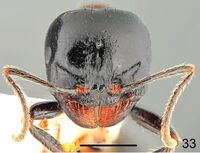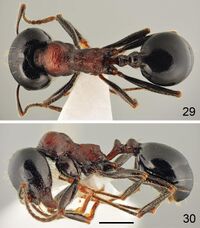Messor veneris
| Messor veneris | |
|---|---|

| |
| Scientific classification | |
| Kingdom: | Animalia |
| Phylum: | Arthropoda |
| Class: | Insecta |
| Order: | Hymenoptera |
| Family: | Formicidae |
| Subfamily: | Myrmicinae |
| Tribe: | Stenammini |
| Genus: | Messor |
| Species group: | instabilis |
| Species complex: | semirufus |
| Species: | M. veneris |
| Binomial name | |
| Messor veneris Salata, Georgiadis & Borowiec, 2023 | |
This species is limited to Greece.
Identification
Messor veneris with Messor danaes are the smallest Balkan members of the M. semirufus complex. The largest majors of M. veneris have HW and HL < 2.0 mm (only two of the studied specimens of M. veneris have HW > 2.0 mm but < 2.1 mm and all studied specimens of M. danaes have HW < 2.0 mm). They are clearly characterised by low numbers of occipital setae, always less than nine. Messor veneris clearly differs from M. danaes in bicoloured body with mesosoma completely or predominantly red while in M. danaes the mesosoma is black. Messor veneris has very distinct and regular background microreticulation of head and first gastral tergite while in M. danaes the head and gaster are smooth and shiny, only with diffused and, especially on the head, hardly visible background microreticulation. Forms of Messor atanassovii, Messor creticus and Messor kardamenae with predominantly red mesosoma clearly differ in numerous occipital setae (7–20 vs 6–8 in M. veneris). Messor kardamenae also differs in relatively shorter antennal scapes with SL/HW ratio 0.64–0.68 (mean 0.659) vs 0.70–0.74 (mean 0.722) in M. veneris. From other species of the M. semirufus complex known from the eastern part of the Mediterranean basin, only Messor syriacus is similar but differs in having larger body with HW in the largest majors up to 2.3 mm and in less evident head sculpture with strongly diffused background microreticulation and the posterior face of propodeum obliquely flat, and never concave.
Keys including this Species
Distribution
Latitudinal Distribution Pattern
Latitudinal Range: 36.6° to 36.6°.
| North Temperate |
North Subtropical |
Tropical | South Subtropical |
South Temperate |
- Source: Salata et al., 2023
Distribution based on Regional Taxon Lists
Palaearctic Region: Greece (type locality).
Distribution based on AntMaps
Distribution based on AntWeb specimens
Check data from AntWeb
Countries Occupied
| Number of countries occupied by this species based on AntWiki Regional Taxon Lists. In general, fewer countries occupied indicates a narrower range, while more countries indicates a more widespread species. |

|
Estimated Abundance
| Relative abundance based on number of AntMaps records per species (this species within the purple bar). Fewer records (to the left) indicates a less abundant/encountered species while more records (to the right) indicates more abundant/encountered species. |

|
Biology
Castes
Worker
Nomenclature
The following information is derived from Barry Bolton's Online Catalogue of the Ants of the World.
- veneris. Messor veneris Salata, Georgiadis & Borowiec, 2023: 134, figs. 29-34 (s.w.) GREECE.
Unless otherwise noted the text for the remainder of this section is reported from the publication that includes the original description.
Description
Worker
Major (n = 5): HL: 1.740–1.920 (mean 1.813); HW: 1.764–2.044 (mean 1.890); SL: 1.273–1.429 (mean 1.353); EL: 0.317–0.360 (mean 0.331); WL: 2.067–2.367 (mean 2.227); MW: 1.016–1.151 (mean 1.080); PSL: 0.241–0.302 (mean 0.267); PW: 0.349–0.413 (mean 0.379); PPW: 0.476–0.548 (mean 0.514); HL/HW: 0.929–0.977 (mean 0.960); SL/HW: 0.699–0.741 (mean 0.722); WL/MW: 2.034–2.083 (mean 2.062); EL/HL: 0.172–0.191 (mean 0.182); PSL/HW: 0.132–0.150 (mean 0.141); PPW/PW: 1.327–1.396 (mean 1.357).
Colour. Head mostly black, only mandibles reddish to reddish brown and frontal triangle reddish, often anterior margin of gena also reddish. Occasionally whole gena reddish and ventral side of head reddish brown. Mesosoma usually red with obscure anterior margin of pronotum and ventral margin of mesonotum and propodeum. Petiole and postpetiole reddish, gaster black, only tergites with reddish or yellowish transparent hind margins. Coxa reddish brown to brownish black, femora and tibiae brown to black, basal segments of hind and mid tarsi brown, apical segments of hind and mid tarsi and whole fore tarsi yellowish to reddish. Antennal scapes mostly dark brown to black with yellowish brown apex, funicle usually completely brown or dark brown basally and yellowish brown apically. Head. Subrectangular, 0.93–0.98× as long as wide, sides below eyes slightly converging anterad, above eyes subparallel then softly convex, posterior margin shallowly concave. Anterior clypeal margin straight, without or with very shallow median emargination, with a row of ten long marginal, yellowish setae, the longest as long as length of clypeus. Clypeus without appressed pubescence, laterally with single erect seta and long erect seta close to the middle of lateral margin of central plate. Surface of the clypeus irregular, with short longitudinal to slightly irregular rugae, median clypeal carinae absent, interspaces microreticulate but shiny. Eyes small and broadly oval, 0.5–0.6× as long as the gena. Frontal triangle impressed, with smooth surface and 2–4 short longitudinal striae, shiny. Frontal carinae short, slightly extending beyond frontal lobes. Frons narrow, in the narrowest part ~ 0.25× as wide as head width. Antennal fossa deep, surrounded by semicircular striae, surface smooth or with diffused microreticulation, shiny. Head mostly with regular and clearly marked background microreticulation and extremely small and sparse pits but shiny. Frons on almost whole surface with clearly marked longitudinal striae and with very narrow short shallow median sulcus, usually with large ocellar cavity behind the median sulcus, gena with short longitudinal striae, area behind eyes as microreticulate as rest of head, without striation. Surface covered with extremely short and sparse, hardly visible white appressed pubescence. Frontal lobes with single long erect seta, and frons behind frontal carinae with single long erect seta and laterally to ocellar cavity with two irregular rows of three or four setae, often broken in mature specimens. Vertex with 6–8 long erect setae placed closer to median impression than in occipital corners, which are without or with single short semierect setae, sides of the head and gena without standing setae, occasionally gena with one or two short semierect setae. Ventral part of the head and inner margin of mandibles with numerous long erect setae, partly forming a J-shaped psammophore. Antennal scape short, in frontal view almost straight only apically slightly curved, without preapical constriction, 0.70–0.74× as long as the width of the head; base of scapus moderately extended, outer angle acute, inner angle angulate. Funiculus distinctly longer than scape, pedicel moderately elongated, ~ 2.5× as long as wide at apex, not flattened dorsoventrally, ~ 0.68× as long as segments 2 and 3 combined and 1.4× as long as segment 2. Surface of the scape with diffused microreticulation, shiny, covered with long and sparse, white, subdecumbent to suberect hairs. Mandibles rounded, with deep striae, surface shiny with a few long and short yellow setae, cutting edge in large majors without teeth or with serrulate edge. Mesosoma. Moderately long, 2.0–2.1× as long as wide. Promesonotum regularly convex in profile with pronotum not or very slightly bulging above mesonotal plate, pronotal sides regularly rounded. Propodeum positioned lower than promesonotum, flat to very slightly convex anteriorly then angulate posteriorly, posterior slope distinctly concave; thus propodeal angle distinct, forming angulate tubercle. Pronotum anteriorly and dorsally with transverse rugae and diffusely microreticulate interspaces but shiny, often anterolateral corners of pronotum with diffused rugae, sides of pronotum with distinct oblique to semicircular striae, and distinctly microreticulate interspaces but shiny. Elevated dorsal plate of mesonotum mostly with transverse rugae, sometimes diffused on top of dorsal plate, interspaces with diffused microreticulation, smooth and shiny, mesopleura with sharp perpendicular rugae and strong microreticulation. Propodeum dorsally, on dorsal half of sides and on posterior face with sharp transverse rugae, in metapleural area with sharp longitudinal rugae, interspaces anteriorly with diffused microreticulation, on metapleuron and posterior face of propodeum smooth and shiny. Vestiture and setation of mesosoma sparse, pronotum with 4–6 long, yellow erect setae, the longest with length 0.300, sides of the pronotum without suberect setae, mesonotum anteriorly and posteriorly with four long erect setae, metapleuron in posterolateral corners with short subdecumbent setae, propodeum with one pair of long erect setae often broken in mature specimens. Petiole. Elongate, with long pedicel and moderately high triangular node, thin, PI 1.5–1.6, pedicel, and base of node with distinct reticulate sculpture, anterior face of node smooth and shiny, sides of node microreticulate and posterior face of node microreticulate and often with fine transverse striation. Top of petiole angulate; upper margin and sides with eight erect setae. Postpetiole. Rounded in profile, globular in dorsal view, 1.3–1.4× as wide as the petiole, whole surface with 8–10 long erect setae and few suberect hairs on top. Gaster. Whole surface of first gastral tergite with well-marked, regular background microreticulation, surface slightly shagreened but shiny, covered with extremely sparse and short appressed hairs, completely without erect setae; second gastral tergite without long erect setae but usually with two short setae close to basal margin. Legs. Moderately elongate, femora distinctly swollen centrally, tibiae moderately widened apically, mid and hind tarsi longer than tibiae. Whole surface of femora diffusely microreticulated, dorsally and laterally covered with moderately sparse and long, decumbent and subdecumbent and ventrally semierect to erect setae. Surface of tibiae covered with sparse and long decumbent to semierect setae.
Minor (n = 5): HL: 1.063–1.190 (mean 1.120); HW: 1.032–1.159 (mean 1.093); SL: 0.937–1.056 (mean 0.982); EL: 0.206–0.238 (mean 0.222); WL: 1.436–1.611 (mean 1.514); MW: 0.675–0.762 (mean 0.716); PSL: 0.179–0.209 (mean 0.192); PW: 0.232–0.270 (mean 0.252); PPW: 0.302–0.349 (mean 0.333); HL/HW: 1.007–1.044 (mean 1.052); SL/HW: 0.878–0.911 (mean 0.899); WL/MW: 2.064–2.187 (mean 2.117); EL/HL: 0.191–0.206 (mean 0.199); PSL/HW: 0.167–0.184 (mean 0.176); PPW/PW: 1.269–1.366 (mean 1.321).
Colour. Coloured as major workers, but sometimes vertex of head reddish and sides of head reddish brown. Head. Slightly more elongated and more rounded in frontal view than in major workers, 1.01–1.04× as long as wide, softly converging anterad and posterad, behind eyes more regularly rounded, occipital margin of the head slightly convex. Clypeus shiny, as sculptured as in majors. Frons mostly smooth and shiny, with short striae laterally, gena with shorter rugae than in majors. Background microreticulation of head not as distinct as in majors but visible on whole head surface. Mesosoma. Almost as slim as in majors, WL/MW ratio ~ 2.1. Pronotal surface with finer rugae than in majors. Sculpture of mesonotum and propodeum as in majors. Propodeal angle less marked than in majors but posterior face of propodeum shallowly concave. Setation and vestiture of mesosoma as in majors but with lower number of setae, mesonotum with only four erect setae, propodeum often without standing setae. Petiole and postpetiole. As in major workers but surface with partly reduced reticulation and striae and with smaller numbers of erect setae. Gaster. Shinier than in majors, with background microreticulation slightly diffused, especially in posterior half of first gastral tergite but always visible on whole surface. Rest of characters as in major workers.
Type Material
- Holotype major worker (pin): GREECE, Cyclades, Milos, | Mount Elias loc. 2, 380 m | 36.6771, 24.3918, 05-06-| 2022 S. Salata CYC118 || Collection MNHW | Formicidae | MNHW-GR03205 (MNHW).
- Paratypes: 10 Paratypes: 2 major, 6 medium, 3 minor workers (pin): the same data as for holotype (MNHW). 12 Paratypes: 7 major, 1 medium, 4 minor workers: the same data as holotype but different nest “Collection MNHW | Formicidae | MNHW-GR03204” (MNHW); 10 paratypes: 5 major, 1 medium, 4 minor workers: GREECE, Cyclades, Milos, | Mount Elias loc. 1, 369 m | 36.6783, 24.3898, 05-06-| 2022 S. Salata CYC117 || Collection MNHW | Formicidae | MNHW-GR03203 (MNHW).
Etymology
Named after Venus de Milo (= Aphrodite of Milos), an ancient Greek sculpture discovered by a Greek farmer named inside a buried niche within the ancient city ruins of Milos – the terra typica of Messor veneris. The epithet is genitive.



